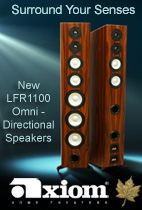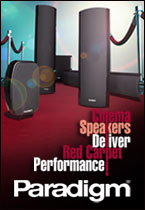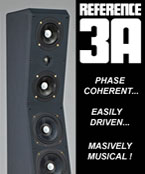“Which came first, the chicken or the egg?” Contemplate on, meanwhile let me illustrate how music and hi-fi share a similar relationship: long before Edison built a phonograph, man made music. So music first…but wait! Just the other night when I listened to Virgil Fox for the first time, I had an epiphany: there’s a chicken in every egg, and an amplifier in every hi-fi system.
Typically amplifiers play with signals, and they are found everywhere: communication systems, control systems, audio, and anytime you have some sort of signal that you don’t want lost in translation. An audio amplifier is a key component of any music or home theatre system and understanding how amplifiers work should prove helpful when building your audio system. A few audio amplifier classes exist today, each having its own merits and shortcomings. The common classes include A, B, AB and D. I’ll go into the differences between these classes later. And let’s not forget about tube amplifiers, but that’s a topic for another time. First, let me explain the basics of how amplifiers work. And don’t worry, I won’t go into technical depth.
An amplifier, like everything else engineered, is a black box that takes an input and gives an output. For this engineering to be an amplifier, the output needs to be the same as the input, only bigger. What I mean is this: a system that takes a chicken and gives a larger chicken is likely an amplifier. It’s not an amplifier, if it spits out a turkey. I’ll stick to this idea until I run into trouble later with digital amplifiers.
All classes of amplifiers have a common goal, which is to give more strength to audio signals. The increase in strength is termed as the “gain” of an amplifier.
How does an amplifier achieve gain? Time to uncover the black box. Inside each amplifier are amplifying devices as well as circuit elements. The amplifying devices come up with the gain, while the circuit elements set them up properly to perform the task.
The operation of an amplifying device is best explained by analogy. Imagine a reservoir, a pipe and a drain. Water flows from the reservoir, through the pipe into the drain, and the flow of water is controlled by a water gate. This gate is the focus: the rate of water flow depends on how wide the gate opens. When fully open, the flow is at a maximum. When closed, water stops flowing. Primitive analogy, but easy to understand.
In an amplifying device, electric current, which is the rate of electron flow, is analogous to the flow of water. Now imagine that the gate is controlled by a small signal much like your input audio signal. Because the electric current is proportional to how much the gate is opened at a particular instant, it has just copied your input signal, and you’ve just found yourself an amplifier. Simple and ingenious.
There are many models of vacuum tubes and transistors that can be used as amplifying devices and they all work in a similar manner. It’s no secret that the design of the channel of flow and the control gate dictates the performance of each device. Each design has pros and cons. Transistors in general fare better on paper than vacuum tubes. The point is that audio manufacturers don’t make tubes or transistors. It’s up to them to choose the right devices and operate them properly. This is where other circuit components come into play, and where amplifier designs start to vary.
Be it with a power amplifier or an integrated amplifier, the gain of power is what everyone is after. Power is the mathematical product of voltage and current, and gain is measured as the ratio of output power to input power, typically expressed in dB (decibel). A gain of 3 dB means a gain of 2, or that power is doubled. But nothing comes from nothing; your amplifiers aren’t power generators. (Even power generators are a bit of a misnomer; they don’t make power from nothing.) So whatever power you demand for bragging rights, you’ll pay for come the next hydro bill.
One fact has always remained true about amplifier design - a plethora of amplifier designs exist and not a single one is perfect. One can only try to balance parameters and hope that the end result comes close to a desired performance. Gain is obviously a parameter. Other big ones are bandwidth, efficiency, distortion, noise, and then, not directly related to amplifier performance but no less important, your wallet.
What is bandwidth? Consider this: nature operates in frequencies. Colours that we see (and don’t see for that matter), sounds that we hear (or can’t hear), are a manifestation of frequencies. In audio terms, the higher the pitch of a note, the higher the frequency. Audio signals have frequency components right across the spectrum, each component with its power. Simply put, the part of this spectrum an amplifier recognizes and acts upon is its bandwidth.
Obviously, a perfect amplifier is one that magnifies all frequencies across the spectrum without bias. Whatever gain it gives to a lower frequency, it applies the same gain to a higher frequency. An amplifier that is capable of such a feat has perfect linearity. But there’s no such luck in the real world. Amplifiers have finite bandwidths and finite gain; and the two don’t work together in harmony. In general, the higher the gain, the lower the bandwidth. In less expensive amplifier designs, you’ll have to choose your favourite - gain or bandwidth. If you don’t want to play favourites, you’ll have to spend more money on an amplifier.
Another parameter of an amplifier is distortion. Signals have an infinitely wide frequency spectrum but amplifiers have a finite bandwidth. So something has to give. Any frequency components that an amplifier “chooses” to ignore are defined as distortion.
The trouble is that our ears are not as good at discerning things as our eyes are, and so most of us can’t trust something until we see it with our own eyes. What I mean is this: what we identify as sounding good or bad, most of the time has no direct relationship with what’s less or more distorted. Whereas in the case of amplifying something visual, we can tell if what we see is too green or too red. Either way, it’s a result of the amplifier acting on one end of the frequency spectrum more than the other.
Of course I am talking in very small scales. A very distorted audio signal will sound horrible even if you can recognize its contents. One of the standard ways of reporting distortion is by means of total harmonic distortion (THD). These days, the THD of amplifiers is often less than 0.001%, but decades ago, before transistors became popular, 0.2% was thought to be acceptable. So we are comparing distortions that are very small relative to the signal itself. And when the differences become this small, it’s hard to tell if the output is a chicken or an egg.
Distortion refers to irreversible changes to a signal that are undesirable. Among the many ways an amplifier can distort a signal, it can do so by dropping wanted frequencies, or by adding unwanted harmonics. THD is the ratio of the power of all unwanted harmonics to the power of the main component.
Another form of distortion stems from the slew rate, which is the maximum rate of change that an amplifying device is capable of. In my analogy above, the gate has a maximum speed of opening and closing, and if it can’t keep up with all the changes in the control signal, the output will be slew-rate distorted. This distortion is called transient intermodulation distortion (TIM).
While distortions are changes to a signal, noise is externally added and may be removed. Electronic systems are susceptible to noise and it’s obvious that part of the design of an amplifier is to keep noise to a minimum, or to maximize the signal-to-noise (S/N) ratio. But like everything in an imperfect world, distortions and noise are the woe of power and the pain of gain. A circuit design that handles more power likely has more distortions and noise.
Something else about an amplifier is clearly illustrated in the above analogy: the maximum flow rate of the water is limited by the size of the pipe and gravity. Because the flow cannot be infinite, there’s a limit to how much power an amplifier can deliver. In an amplifier, when the “pipe” is too small for the required power, the audio signal will clip and transistors might toast like turkeys.
Because nothing comes from nothing and yet we all hunger for more power, amplifier efficiency should not be overlooked. The water-gate analogy presents a straightforward topology known as a class A amplifier. This means that it amplifies everything in the signal, high or low, and that the device is turned on all the time. The efficiency of class A amplifiers is never more than 50 percent, which means at least half of the power is dissipated as heat by the device. Though, if you plan on using the amplifier as a heater in the winter, and don’t mind spending the dough, it’s not so much of a problem.
Greener souls try class B amplifier designs, where the device conducts half of the waves in a signal and turns off for the other half. This means that a second device is needed for the other half-waves, turning on and off in a manner similar to the first device. A perfect class B implementation has 100 percent efficiency. Real world implementations have very high efficiency values as well, but class B suffers a major flaw known as crossover distortion, when the signal switches from one device to the other.
A compromise produces the class AB amplifier, whose crossover distortion is acceptable, while its efficiency remains superior to class A amplifiers. Though, because class A amplifiers don’t have any crossover problems, they are often chosen for superior sound quality in high-end music systems. Power? Wasted shmasted!
The latest class of amplifier design is class D, or digital amplifiers. However, be aware that not all class D amplifiers are completely digital. Some are chicken-turkey systems if you will. That’s because some class D amplifiers accept an analog signal and use an analog control system, while others use a digitally generated control. Digital amplifiers are highly efficient with power conversion at over 90% (only 10% or less is lost to heat), they are virtually immune to noise, the digital signal path does not rely on analog component tolerances, and they offer greater flexibility and configurability of the signal path. But like all other amplifier designs, digital amplifiers are not perfect. Class D amplifiers are susceptible to quantization and sampling errors. For a more in-depth conversation about digital amplifiers, please read the ‘Digital Amplifiers’ article on www.canadahifi.com.
Finally, I should point out that other less common amplifier topologies also exist. A good example is Arcam’s class G design. This unique design shifts the signal among output transistors that operate at different voltages – something called rail switching. This helps to save energy since not all of the output devices need to be active at the same time. The benefit of this topology is the ability to get more voltage swing into 8 ohms without getting too hot. The goal of this design is to achieve absolute quality over the highest possible quantity of output.
Deciding which type of amplifier to implement in your music or home theatre can be a challenging but should also be a fun experience. The truth is that a perfect amplifier design does not exist but, fantastic sounding amplifiers can be found in every class. The sound characteristics of one amplifier compared to another can very substantially, even if both belong in the same design class. Every manufacturer uses a unique approach and different components in their amplifier design, which results in a distinct sound. As with any audio component, there is no substitute for listening to the product with your own ears. So get out there and listen to a good number of amplifiers before you pull out that credit card.
Click here to discuss this article on the CANADA HiFi Forum











